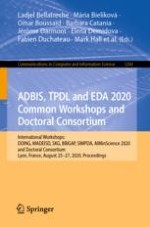2020 | Buch
ADBIS, TPDL and EDA 2020 Common Workshops and Doctoral Consortium
International Workshops: DOING, MADEISD, SKG, BBIGAP, SIMPDA, AIMinScience 2020 and Doctoral Consortium, Lyon, France, August 25–27, 2020, Proceedings
herausgegeben von: Ladjel Bellatreche, Prof. Mária Bieliková, Prof. Omar Boussaïd, Barbara Catania, Prof. Jérôme Darmont, Dr. Elena Demidova, Dr. Fabien Duchateau, Mark Hall, Tanja Merčun, Boris Novikov, Christos Papatheodorou, Prof. Dr. Thomas Risse, Dr. Oscar Romero, Lucile Sautot, Guilaine Talens, Dr. Robert Wrembel, Maja Žumer
Verlag: Springer International Publishing
Buchreihe : Communications in Computer and Information Science
